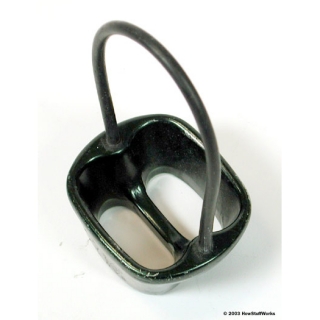Safety on the Rocks
If you climb, I'm sure you've been asked why you climb. The immediate assumption of many flat-landers is that climbing is dangerous. Therefore, a climber must either be an adrenaline junky or there is some faulty cerebral wiring involved. The irony, herein, is that most climbers are neither.Certainly, the consequences of a safety failure are catastrophic. However, the margins of safety that exist in modern mountaineering provide an environment that is safer than many, more common, outdoor activities, and far safer (statistically) than driving on the highway at 75mph.
So, how do we stay so safe when we're caught between a rock and... gravity? There's a system. In climbing, the simple idea is that we use a combination of safety equipment to keep us from hurting ourselves if we should make a misstep.
The most visible and obvious part of the safety system is the rope. Climbing ropes are actually several--slightly elastic--ropes made out of Kevlar and other polymers that are intertwined and encased in a weather- and wear-resistant sheath. The end result is a single rope that has the tensile strength of a heavy-duty steel chain for a tiny fraction of the weight.
From what I remember of 5th-grade gym class, hanging onto ropes with your bare hands is not the party everyone makes it out to be. To connect our body to something, we wear a sewn nylon waist harness. It's basically a bullet-proof belt with some leg loops to keep the belt from riding up into our ribs.
To attach the rope to something, we use a variety of anchors connected to the rock. This can range from expanding masonry bolts placed inside pre-drilled holes, to more environmentally-friendly "clean" anchors that take advantage of natural features of the rock surface to make remarkably strong fixtures that can be easily removed.
Once we have a harness attached to a rope that is feeding through anchors, we enlist the help of a buddy to regulate how the rope feeds through the anchors. This person and the task they perform is referred to as the belay. Just like it sounds, their job is to stop you should you let gravity win for a few seconds. How the belay is set up can vary based on the type of terrain. Typically, the belay stands at the bottom of the climb. As the climber ascends, he places a series of anchors progressively up the route. In the event of a fall, the belay will cinch the rope tight in a mechanical friction device attached to their harness which ensures the climber will never fall much past the last anchor.
I hope this demonstrates some of the fundamental aspects of how climbing isn't that dangerous. There is risk in most activities. The risk of climbing is severe, but the safety system provides a safe and sane environment to explore our third dimension.
